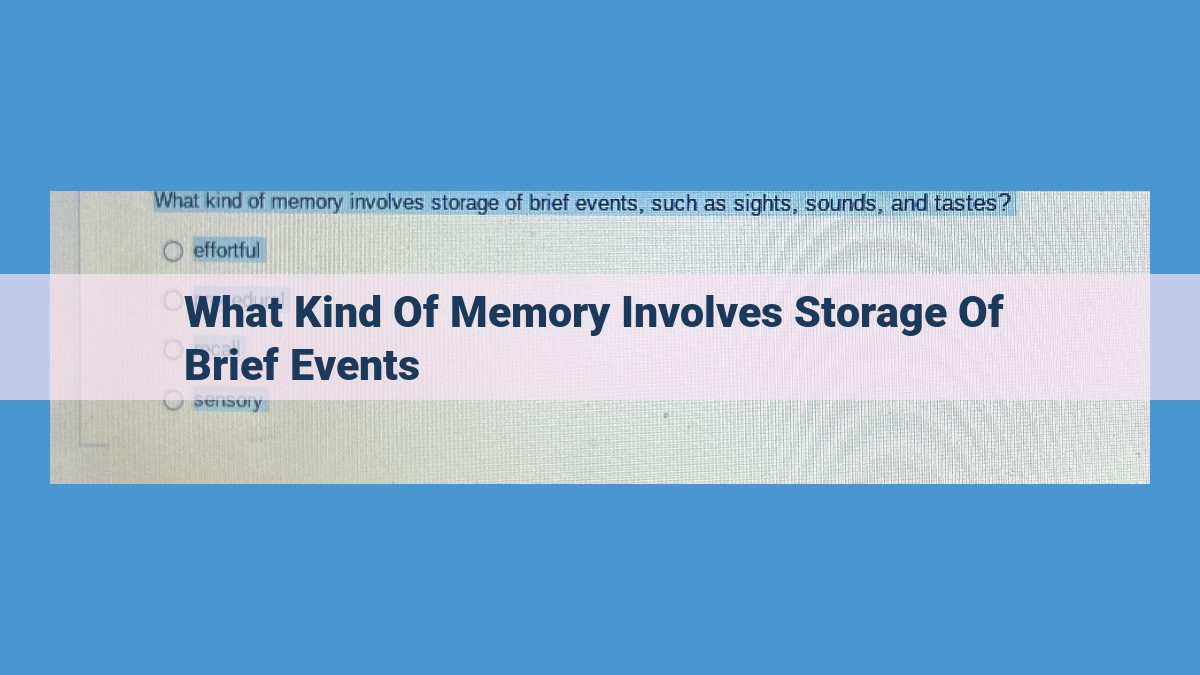Sensory memory briefly retains sensory information, facilitating immediate perception. Its limited duration and large capacity allow for a snapshot of sensory input, which is essential for transitioning information to higher-level memory systems like short-term memory.
Short-Term Memory: The Transient Keeper of Information
Imagine a busy highway where cars zip by at lightning speed. Just like these cars, short-term memory is a bustling hub where information races in and out of our minds. It’s like a temporary holding bin that keeps important details at our fingertips, but only for a fleeting moment.
The capacity of short-term memory is remarkably limited. Think of it as a tiny parking lot with just a handful of spaces. Once it’s full, new information coming in pushes the oldest out, like cars jostling for a spot. This limited space forces us to prioritize the most crucial pieces of information.
Moreover, short-term memory is a transient traveler, lasting mere seconds or minutes. Like a whisper in the wind, it’s gone in an instant unless it’s actively repeated or rehearsed. This fleeting nature challenges our ability to hold onto information for long periods.
Within the realm of short-term memory, two key concepts emerge: working memory and sensory memory. Working memory is the conductor that orchestrates active information processing. It’s like a mental whiteboard where we manipulate and juggle information in real time. It collaborates closely with short-term memory, providing a bridge between incoming sensory input and long-term storage.
Sensory memory, on the other hand, is a momentary snapshot of sensory experiences. Like a camera’s shutter, it captures sensory information (visual, auditory, touch, smell, and taste) for a fraction of a second. This fleeting memory allows us to make sense of our immediate surroundings and interact with our environment.
Working Memory: The Cognitive Powerhouse
Imagine a mental workspace where you can juggle thoughts, process information, and make quick decisions. That’s working memory, the cognitive superhero that powers your everyday functioning.
Working memory is the central hub for active information processing. It’s like a temporary holding tank where you keep the essential bits of information you need to complete ongoing tasks, such as remembering the grocery list or following instructions.
Unlike short-term memory, which stores information for a few seconds, working memory actively manipulates and transforms it. It’s the engine that allows us to solve problems, comprehend complex ideas, and learn new skills.
Furthermore, working memory acts as a bridge between short-term and long-term memory. It takes the information from short-term memory that needs to be retained long-term and transfers it to long-term storage for permanent access.
Therefore, working memory is not just a passive storehouse but an integral part of our cognitive arsenal. It’s the unsung hero that enables us to perform the complex mental tasks that define our human experience.
Sensory Memory: Capturing a Fleeting Sensory World
In the realm of memory, the human brain orchestrates a remarkable symphony of information processing and storage. Among the various memory systems, sensory memory plays a crucial role in capturing the raw sensory input from our environment, creating a vivid snapshot of the world around us.
Definition: The Transient Repository of Sensory Input
Sensory memory, as the name suggests, is a brief and specialized memory system responsible for holding sensory information for an incredibly short duration, generally less than a second. It serves as a gateway, receiving and temporarily storing sensory data from our various senses, including:
- Visual sensory memory (iconic memory): Captures a photographic-like image of what we see, lasting for about a quarter of a second.
- Auditory sensory memory (echoic memory): Stores acoustic information we hear, retaining it for a slightly longer duration, approximately three to four seconds.
- Olfactory sensory memory: Holds odors and scents we encounter, but with a limited lifespan and capacity compared to visual and auditory memories.
- Tactile sensory memory: Records tactile sensations, such as touch, pressure, and temperature, for a brief period.
- Gustatory sensory memory: Stores tastes we experience, but its duration and capacity are still subjects of ongoing research.
Importance: A Bridge to Higher-Level Memory
Sensory memory plays a vital role in our immediate perception of the world. It provides a temporary buffer where sensory information can be held long enough for higher-level memory systems, such as short-term memory (STM) and long-term memory (LTM), to process and consolidate it.
Without sensory memory, we would be unable to make sense of the constant stream of sensory data bombarding our senses. It allows us to integrate and interpret sensory input, forming a cohesive perception of our surroundings.
By filtering out irrelevant information and prioritizing important sensory cues, sensory memory ensures that the most critical information is passed on to higher-level memory systems. It also acts as a buffer, preventing sensory overload and giving us time to process one piece of sensory information before the next arrives.
In short, sensory memory is an essential component of our memory system, providing a fleeting yet crucial snapshot of our sensory experiences, bridging the gap between raw perception and meaningful memory.
